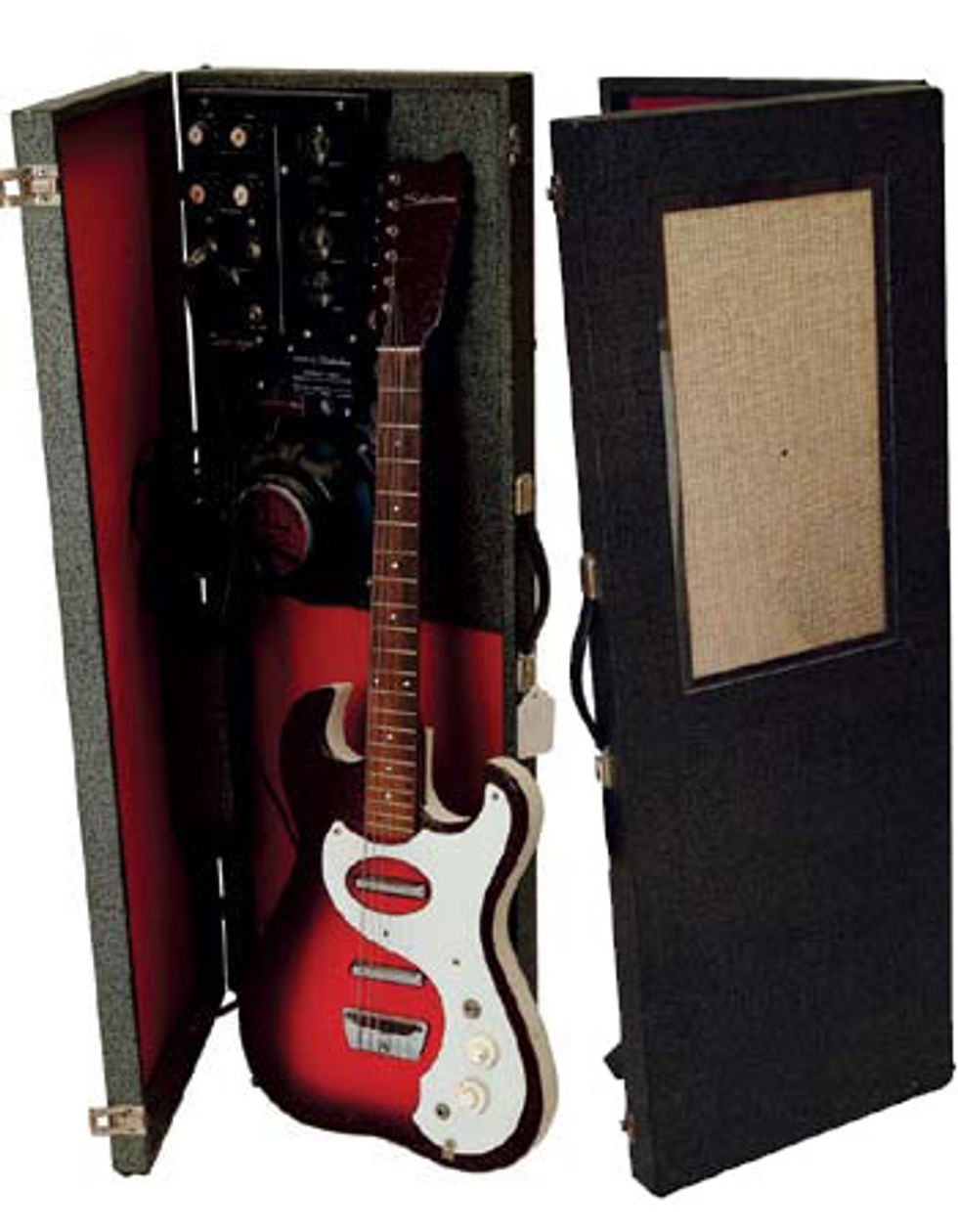 LEFT: This '60s Silvertone 1457 was built by Danelectro and came with
a case that featured a 5-watt tube amp powering an 8" speaker.
RIGHT: To use the amp, you had to open the case and stand it on its
end. Owning one of these surely made any guitarist the life of the party.
LEFT: This '60s Silvertone 1457 was built by Danelectro and came with
a case that featured a 5-watt tube amp powering an 8" speaker.
RIGHT: To use the amp, you had to open the case and stand it on its
end. Owning one of these surely made any guitarist the life of the party.Hey Zach,
I bought a Silvertone guitar with an amp built into the case
because of how cool it is. Can you tell me a little bit about
who built these guitars, how much are they worth today, and
why this guitar and “amp-in-a-case” package never caught on?
Thanks
—Neil in Atlanta, Georgia
Hey Neil,
What a great piece of
Americana! This is the same
guitar that Lenny Haise (played
by Steve Zahn) plays in the
movie That Thing You Do!,
before the fictional band hits
it big and purchases more
expensive instruments. It is a
cool item nonetheless and, in
my opinion, was the first “allin-
one-pack” option that has
become so popular for many
manufacturers today.
The Silvertone name appeared on a lot of guitar headstocks (and amps) during the 20th century, but it was strictly a trademark. Silvertone was never a manufacturer. Sears & Roebuck sold a variety of instruments in their mail-order catalogs, and Silvertone was their largest guitar and amplifier line. Guitars were initially supplied by large manufacturers like Harmony and Kay, both out of Chicago, but the majority of Silvertone guitars produced in the late 1950s and 1960s (including this particular model) were made by Danelectro in New Jersey.
In the early 1960s, Silvertone, Danelectro, or Sears & Roebuck (it is unknown whose idea it was), decided to capitalize on the increasing popularity of guitars and began offering an all-in-one package for the entry-level guitarist. The package included a guitar, a case with a built-in amplifier, cord, pick, chord charts, and a howto- play 45 rpm record—everything a beginner would need to get started! Five different variations of this package were available, including options for single- or double-pickup guitars, 3- or 5-watt amplifiers, and onboard tremolo.
Your 1457 model was offered between circa 1964 and 1966. The guitar features a double-cutaway design on the Masonite-covered pine body, a Brazilian rosewood fretboard with 21 frets (yes, it was advertised as Brazilian), an in-line scoop headstock, a Masonite pickguard, two lipstick pickups, concentric (stacked) Volume and Tone knobs, and a 3-way switch. It has a red sunburst finish with silver accents that give the guitar its sparkly appearance. And the amp boasts 5 watts of power that drive an 8" speaker, a triple-tube chassis plus a rectifier, and footswitchable tremolo.
This package was quite appealing during the guitar boom of the 1960s, with sales to prove it. Because Silvertone produced five variations of the guitar and amp-in-the-case package, multiple options were available to not only beginners, but to mid-level and advanced players who liked the convenience of having everything all-in-one. However, after Silvertone discontinued these packages, we really haven’t seen a mass-produced, amp-in-thecase product since. Why is that?
I believe a number of reasons have prevented an amp-incase package from becoming a standard item in the music industry. Amplifier speakers are housed in a cubical cabinet for a reason—they project sound better. The Silvertone cases were essentially made of cardboard and need to be propped open to access the controls. Imagine a speaker sitting on the floor of your room—how powerful would it sound? Durability was certainly an issue since cases get thrown around, thereby increasing the chances of the amplifier itself being damaged. Gig bags are relatively new for carrying guitars, but they are lighter, easier to transport, and cheaper to produce. Manufacturers today often package existing guitars and amplifiers in their line together, instead of producing a special case with a built-in amp.
Because of their uniqueness and relatively short period of production, these guitar and amp-in-the-case packages are collectible. Currently, examples in excellent condition with fully working components (amp and footswitch included) are valued between $600 and $800. The cool thing about these packages is that you can use each piece individually. In other words, the guitar can be plugged into a different amp and the amp-in-the-case will work for any other guitar. Some packages from this era, like the Epiphone EA-8P Professional, only worked with the included guitar and amp.
Director Tom Hanks and his crew must have known something about this guitar to show Lenny playing it when the Oneders were an unknown garage band, and then replacing it with a Fender Jaguar once they hit the big time. This entry-level package from the 1960s started the practice of offering guitar/ amplifier packages for beginners, still used today by many manufacturers. Not to mention that it’s a great piece of Americana that many consider a treasure.
 Zachary R. Fjestad
is author of Blue Book of
Acoustic Guitars, Blue Book
of Electric Guitars, and Blue
Book of Guitar Amplifiers.
For more information, visit
bluebookinc.com or email
Zach at guitars@bluebookinc.com.
Zachary R. Fjestad
is author of Blue Book of
Acoustic Guitars, Blue Book
of Electric Guitars, and Blue
Book of Guitar Amplifiers.
For more information, visit
bluebookinc.com or email
Zach at guitars@bluebookinc.com.








![Rig Rundown: Russian Circles’ Mike Sullivan [2025]](https://www.premierguitar.com/media-library/youtube.jpg?id=62303631&width=1245&height=700&quality=70&coordinates=0%2C0%2C0%2C0)

















